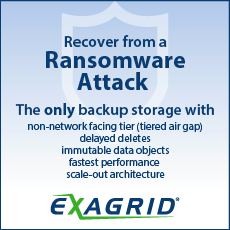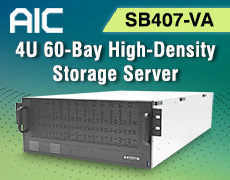IBM Releases Storage Ceph 8.1
File storage accessible by SMB and NFS, block storage for VMware, and AWS S3 compatible Object storage alongside with multiple enhancements
This is a Press Release edited by StorageNewsletter.com on June 18, 2025 at 2:39 pmBy Marcel Hergaarden, product manager, IBM Storage
IBM Corp. releases Storage Ceph version 8.1, with general availability.
About IBM Storage Ceph
Software defined storage for Block, Object and File storage services, with enterprise level improvements and updates. IBM Storage Ceph can deliver file, block and object storage services from within one single technology stack, supporting clients to cut CAPEX and OPEX. A complete IBM software defined storage platform, consumable as a service, or as software subscription, also available with IBM Storage Ready Nodes hardware servers, as complete storage offering.
IBM Storage Ready Nodes for Ceph
IBM optionally offers IBM Storage Ready Nodes for IBM Storage Ceph clients.
Storage Ready Nodes concerns server hardware, which has been fully tested and qualified for IBM Storage Ceph implementation and production use cases. Storage Ready Nodes for Ceph enable IBM clients for a complete storage software- and hardware solution experience.
Storage Ready node feature- and capacity choices are available with multiple configuration choices and options, depending on a client’s use cases and use patterns. On-site implementations are feasible by IBM consulting services.
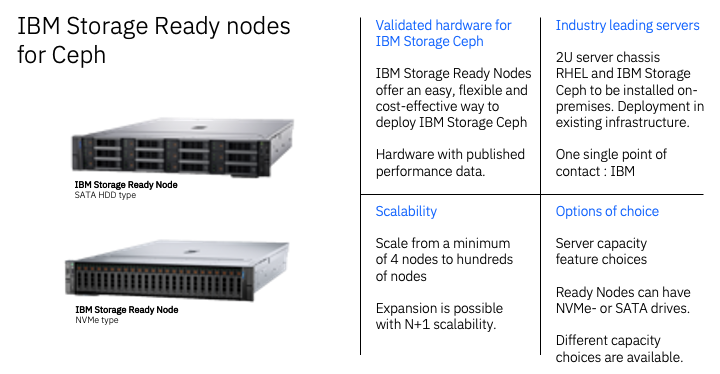 What’s delivered in this IBM Storage Ceph 8.1 update release:
What’s delivered in this IBM Storage Ceph 8.1 update release:
Storage Ceph RADOS core updates:
-
Storage Ceph stretch cluster update
IBM Storage Ceph 8.1 enables support for 2-site + tiebreaker stretch-mode clusters.
With this capability, clients can lose a site without impact to the availability of their data resources.
-
Storage Ceph Health warnings
Health warnings on fragmentation.
Log status of the cluster and advice operator on remediation course of action.
Health warnings alert administrators to potential issues before they escalate into actual problems. Reducing risk of failures and downtime.
-
Reduced block.db device requirement
Lowers the fast storage requirement for block.db placement, lowering TCO for Storage Ceph clients. The fast storage requirement (SSD, NVMe) for block.db placement is lowered, for Object Storage. From 4% of the storage pool to 2.5% for RGW workloads.
-
Crimson BlueStore backend
Crimson OSD, in use with IBM Storage Ceph BlueStore backend,
resulting in higher read performance. Improving performance, reducing complexity and further enhance maintainability and reliability.
All compatible with the existing Storage Ceph ecosystem.
Storage Ceph RADOS Block Device (RBD) updates:
-
Rados Block Device consistency groups
Allows for creation of consistent snapshots of multiple RBD images belonging together and offers the ability to create consistency group mirror snapshots for rbd-mirror.
Functionality to replicate images correctly within a consistency group as requirement to restore application data in a consistent state.
-
Project Espial support
Espial is also part of IBM Storage Defender. Espial is about ransomware prevention and recovery tool by IBM. The block interface is supported with IBM Storage Ceph. Supporting use cases that consume Ceph RBD and NVMe/TCP block storage.
Storage Ceph NVME/TCP Block storage updates:
- Enhanced network-based Block storage for VMware
- IBM Storage Ceph 8.1 offers enhanced NVMe/TCP access to Ceph (RBD) block storage.
- NVMe/TCP enables access to Ceph RBD block storage with non-Linux clients.
This functionality allows VMware vSphere to connect with IBM Storage Ceph and use Ceph block storage as VMware VMFS storage resourcing.
NVMe/TCP block storage updates with IBM Storage Ceph 8.1:
-
Auto namespace load balancing
In scale down and scale up scenarios, this automatically spreads namespaces across available NVMe/TCP gateways. It enables Storage Ceph to respond to real-time changes in workload demands. It also helps clients to ensure that resources are being used efficiently as this avoids overloading gateways while underutilizing others.
-
NVMe/TCP Storage Ceph CLI integration
Ceph command line interface, Ceph CLI, is a tool to interact with and manage a Storage Ceph cluster.
It allows administrators and users to perform various operations on an IBM Storage Ceph cluster. In example: Cluster and Storage management, Monitoring, and troubleshooting.
Direct podman command line interactions will also remain to be working.
New in IBM Storage Ceph 8.1 is Ceph CLI integration for NVMe/TCP interactions. System administrators can now also invoke Ceph CLI commands to interact with NVMe/TCP components.
-
NVMe/TCP – Backup ISV Partner Readiness and certification
Examples of supported ISV parties are: IBM Storage Protect , Cohesity , Veeam, Commvault , Rubrik. More ISV parties and details are available in IBM Storage Ceph’s online documentation.
-
NVMe/TCP cluster-wide multi-tenancy
Multi-tenancy provides data isolation, meaning that tenants data is kept separate and secure. This allows multiple clients to use the same cluster resources while remaining to keep data private. Shared resources usage also implies efficiency and cost-effectiveness for the business.
Cluster-wide multi-tenancy in Storage Ceph provides clients with the ability to isolate namespaces. Namespaces can be identified by tags or other attributes.
NVMe/TCP clients are handled as separated entities aka tenants.
-
NVMe/TCP per-namespace masking
For any workload which requires isolation from an NVMe Qualified Name (NQN) initiator to a single namespace. Per-namespace masking is useful where namespaces require isolation on a per-volume basis, such as multi-tenancy and security.
-
NVMe/TCP In-band authentication
In-band authentication for NVMe/TCP Gateway is implemented as a preventive security measure. This asserts security posture versus unknown connection requests, coming from unauthorized or unknown initiators.
Storage Ceph CephFS File storage updates:
-
Support for SMB and NFS access to CephFS resources
- SMB – Server Message Block
Enables clients to access CephFS filesystems by MS Windows file shares.
This functionality includes support for MS Active Directory and Windows ACLs.
CephFS over SMB also includes built-in resilience against storage node failure.
The Storage Ceph UI enables for Management of shares, permissions, etcetera. All configurable through the Ceph Manager.
- Dashboard UI – SMB service and share management
SMB service and share management through use of the Ceph dashboard UI.
Basic deployment, Day-2 management, and monitoring capabilities for Storage Ceph SMB services and shares.
- Management functional abilities
- Setup SMB services on one or more cluster nodes.
- Setup Active Directory integration with an external AD-Service.
- Create, list, change, delete SMB-Shares.
- Monitor health status of SMB services and shares.
- Monitor basic I/O-statistics for SMB services.
- NFS – Network File System
Clients can create, edit, and delete NFS exports from within the Ceph dashboard after configuring the Ceph filesystem. CephFS namespaces can be exported over NFS protocol, using NFS v4.1, NFS v4.2 or NFS v3 service.
Ceph Object storage, RADOS Gateway (RGW) updates
-
Object Retrieval from Cloud or Tape S3 tiers
New option to retrieve migrated objects from external cloud or tape resources in a transparent and automated way. -
Extended ISV certifications for Storage Ceph RGW as S3 target store
More detailed information about supported ISV vendors can be found here.
-
Multitenancy with IAM Accounts
Ability for RGW/Storage Ceph admin to create an IAM account with an
IAM specific root user account per tenant. GA in Storage Ceph 8.1.
-
Staggered upgrades by topological labels
An ability to upgrade IBM Storage Ceph components in phases, rather than all at once. This can be done within a single command.
Clients may have preferences to upgrade components in phases rather than all at once. Clients can now perform staggered upgrades by passing either of the following flags: –daemon-types, –services, –hosts, –limit.
This new feature allows clients to provide topological key/value information about specific assets in the cluster with respect to the upgrade command.
-
Storage Class Management in Dashboard UI
A new ability for managing Storage Classes from the UI.
Object Lifecycle policies were already introduced earlier, in Storage Ceph 8.0.
Lifecycle policies allow, among other things, the configuration of data from one Storage Class to another.
With IBM Storage Ceph version 8.1, Storage Classes can now be configured from the dashboard UI.
Storage Class management can also be used in context of multi-site configurations. In RGW Multisite configuration, placement targets can be configured. Placement targets not related to multisite replication could be moved to another storage class, in a different section.
Summarizing
The company has released IBM Storage Ceph 8.1 GA, with new features and functionalities.
Main significant highlights of this release:
RADOS updates
-
Rados Block Device consistency groups
Allows for creation of consistent snapshots of multiple RBD images belonging together
-
Espial support
Espial is about ransomware prevention and recovery tool by IBM.
Espial is part of IBM Storage Defender.
Storage Ceph Block storage
- RBD Block
NVMe/TCP block storage for VMware enhancements and updated features.
- CephFS
SMB v2 and SMB v3 Windows file access, including MS Active Directory support.
NFS v3, v4.1 and v4.2, enabling file access for non-native Ceph clients.
- RADOS gateway
GA multitenancy feature with IAM and other functional features.
- Dashboard UI
Extended UX functionalities, new cluster configuration options and security enhancements.
Resources:
IBM Storage Ceph website
IBM Storage Ceph documentation
IBM Storage Ceph video demos
IBM Redpaper publications:
Concepts and architecture of IBM Storage Ceph
Step-by-step implementation of some of the common scenarios with IBM Storage Ceph









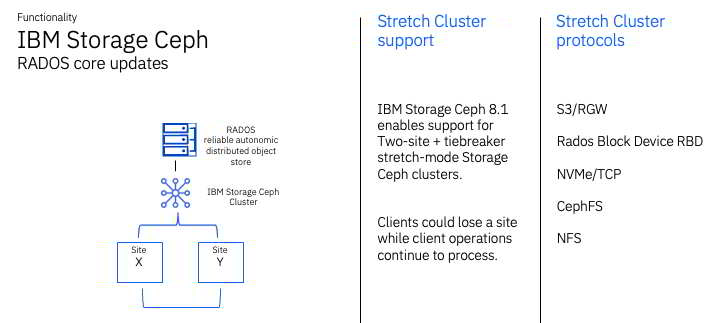
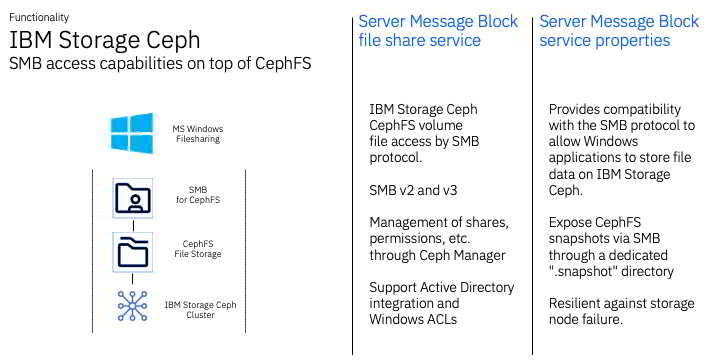
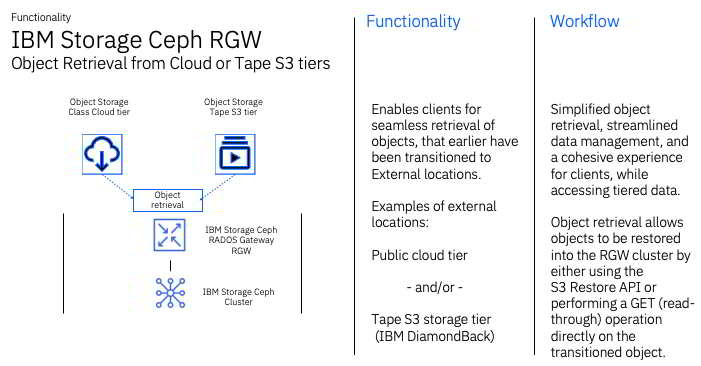
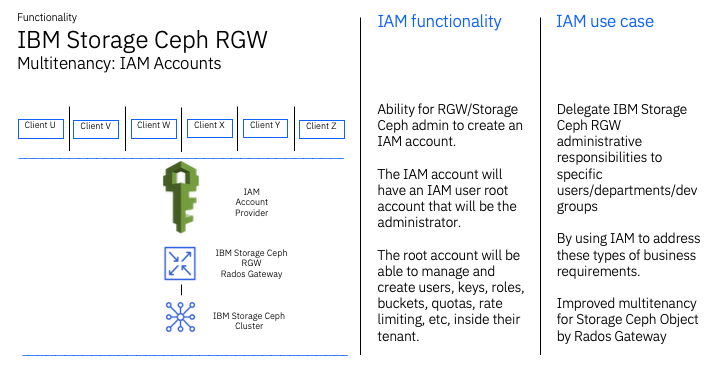






 Subscribe to our free daily newsletter
Subscribe to our free daily newsletter
